Doctor William Christmas' - Bullet
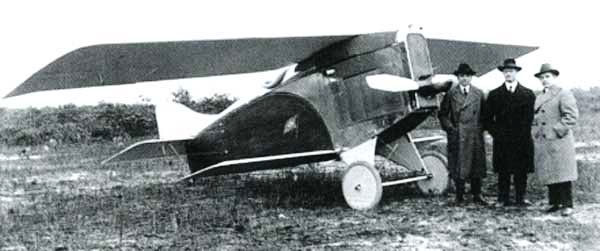
Doctor William Christmas believed that struts were unnecessary and that an aeroplane's wings should be free to flap like a bird's. Unfortunately, on the first flight of his 'Bullet' fighter, also known as the Christmas Strutless Biplane and by other names, the wings did exactly that and then came adrift. The pilot was killed instantly. A second Bullet did exactly the same thing a few months later. Christmas claimed all sorts of things, among them that he had 'hundreds' of aeronautical patents and that he was swamped by orders for Bullets from Europe and by million-dollar offers to rebuild Germany's air forces. None of them was true, but he did get the US Army to pay him handsomely for his wing design. Or so he said.
One of the more extravagant claims made to the US military authorities by William Christmas was that he could design an aircraft capable of flying to Germany on a mission to kidnap Kaiser Wilhelm II. He did receive a patent for the Bullet design in 1914, and later claimed to have sold the rights to his design for moveable ailerons in 1923, for $100,000. However, this has never been substantiated and Christmas remains branded by history as a potential genius who fell victim to flights of fantasy.
Christmas Bullet
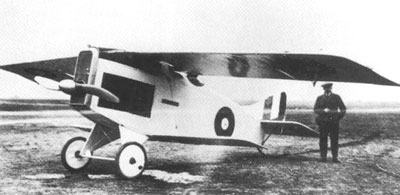 To those who first met him, the lively and dapper Dr Christmas was a friend indeed for a time of need-the man who would make the new and reckless world of aviation a safer and better one for all mankind. In the 20/20 hindsight of history, however, William Christmas, of Warrenton, North Carolina, was perhaps the greatest charlatan to ever see his name associated with an airplane.
To those who first met him, the lively and dapper Dr Christmas was a friend indeed for a time of need-the man who would make the new and reckless world of aviation a safer and better one for all mankind. In the 20/20 hindsight of history, however, William Christmas, of Warrenton, North Carolina, was perhaps the greatest charlatan to ever see his name associated with an airplane.
We say perhaps, because even today it is hard to figure whether the good doctor (they say that he really was a doctor of medicine) was a fraud and a scoundrel, or just a naive eccentric.
In any case, he arrived on the scene in 1918 with a fanciful tale about having built and flown airplanes as early as 1907, and about having established his Christmas Aeroplane Company in 1912. Somehow, though, there was nobody that could be found who had ever seen a Christmas Aeroplane-in the air, or on the ground. His objective in 1918 was to construct an aircraft for the purpose of kidnapping Kaiser Wilhelm II of Germany. This was despite his story of having been offered a million dollars in gold in 1914 to 'take over' Germany's aircraft development.
Incredibly, he had little trouble convincing a number of people that he was not only an experienced aviation pioneer, but fully able to carry out the abduction of the Kaiser. This being the dark depths of World War I, there was probably at least a little wishful thinking involved.
First to fall under his spell were Alfred and Henry McCrory of the New York brokerage firm of the same name, who promptly enlisted the support of Senator James Wadsworth in obtaining aircraft engines - hard to obtain in wartime - for the project. Meanwhile, the nearly-bankrupt Continental Aircraft Company of Amityville, Long Island was enlisted to build the airframe to Dr Christmas' specifications. Eventually Senator Wadsworth convinced the Army to supply an engine, but they did so with the caveat that they allow the Army to see and test the airplane before it was flown.
The 'specifications' that Dr Christmas had in mind (he was afraid to commit them to paper) were so bizarre that even the Continental people- who were desperate for business - thought twice. Simply put, he was breaking every rule in the book. His overriding theory of aircraft design was that struts and bracing should be eliminated, and that the wings should be so flexible that they could literally flap like a bird's! To top this unorthodoxy, Dr Christmas insisted on constructing his airplane of steel and hardwood.
Now nicknamed 'Bullet' for no obvious reason, the Christmas aircraft was completed in the fall of 1918, but the war ended before it could be flown. One problem was that the doctor couldn't find a pilot. One by one they looked it over, tried the controls and walked away shaking their heads. Finally, Dr Christmas was able to lure a pigeon from among the ranks of the unemployed Army Air Service pilots returning from the war.
Ironically, it was just after Christmas time in 1918 when Cuthbert Mills took the Christmas Bullet up for her maiden flight. He got it airborne successfully, but within moments the flimsy wings twisted and peeled from the heavy fuselage and the Bullet fell like a lead projectile, taking Mills to his death. Undaunted, Christmas hardly broke stride. Even though he had flown the Bullet without telling the Army-as he'd promised- and had destroyed their engine, he had no qualms about going back to them in February 1919 to ask for help getting a propeller for his second Bullet.
In March 1919, Christmas put the second Bullet on display at the New York Air Show, where he had the audacity to advertise it as the 'safest, easiest controlled plane in the world.' It was the same airplane that was destined to destroy a barn and a second test pilot's life when it was flown for the first time. 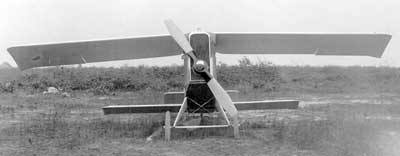
In a stereotypical morality play, Christmas would have been unmasked and duly punished. In fact, he simply went on to still grander prevarications, even going so far as to go before the US Congress to tell them that his Bullets were the fastest, safest and most efficient airplanes on Earth, and that he was being swamped by orders from Europe. In actual fact, there were no orders - and indeed no Bullets! This didn't bother Dr Christmas, who in 1923 impudently billed the US Army $100,000 for his 'revolutionary' wing design. He had to have had a gift of charm that has been exceeded by few men in history. The Army paid the bill.
Dr William Christmas died quietly in 1960 at age 94 with money in his pockets and blood on his hands. His was the kind of tale that they used to write folk songs about.
They called him Dr William Whitney Christmas, though that may not have been his name, and his medical diploma probably reached him by mail order. His airplane was called the Bullet Biplane, although its plywood hull resembled a wedge of cheese. Its wings, designed to flap like those of a bird, defied controllability and simply refused to stay attached to the airplane once it became airborne. In March 1919, three months after the first Bullet (seen here) killed its pilot, Christmas took a display at the New York Air Show for his Cantilever Aero Company, which he used as a platform to advertise the identical and yet unflown second Bullet as the 'safest' in the world. It was later to kill its pilot on its first flight.
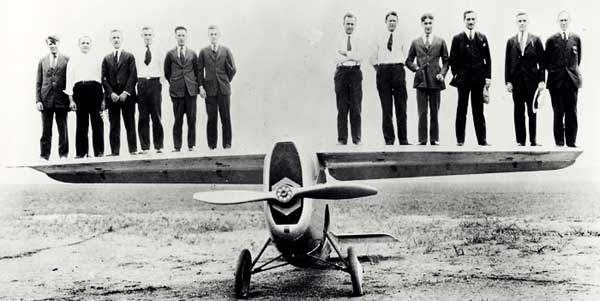
Dayton-Wright purchased the Christmas Bullet and redesigned it, you can see from this image that the redesign was a far stronger wing structure.
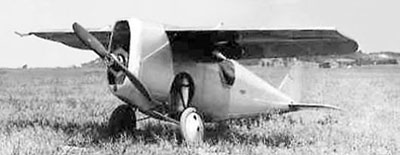
Specifications of the Christmas Bullet
Length: 26 ft Wingspan: 28 ft Wing area: 170 ft² Empty weight: 1,820 lb Gross weight: 2,100 lb Powerplant: 1 × Liberty 6, 185 hp Performance Maximum speed: 175 (anticipated) mph Range: 550 miles Service ceiling: 14,700 ft |
 |
||
| A: The first Bullet's engine was a Liberty Six, a cut-down version of the famous V-12 Liberty. The army were upset that Christmas flew the first Bullet and wrecked their expensive engine without notifying them. | B: There was no bracing at all between the upper and lower wings, although it was considered worthwhile to brace the tailplane. | C: The Bullet was one of the first aircraft with a veneer-clad fuselage, which had reduced skin drag compared to traditional fabric covering. |

